Top Learn-and-Earn Platforms for Crypto Beginners
Vuk Martinovic


Starting with crypto usually means putting your own money on the line. But what if learning about crypto actually paid you?
That’s the idea behind Learn-to-Earn (L2E) platforms. They offer short lessons that reward you with tokens, NFTs, or platform credits.
It sounds simple enough. The tricky part is choosing where to start. Some platforms only run limited campaigns, others keep lessons rolling, and a few have regional restrictions.
In this guide, we’ll walk through the top choices, how they work, and what kind of rewards you can expect as a beginner.
What is Learn-to-Earn (L2E)?
Learn-to-Earn (L2E) is a simple idea: you learn about crypto, and you earn a reward for it. Instead of paying to join, you get a small bonus for completing lessons.
The pattern
Most L2E programs follow the same steps:
- Watch or read: Short videos, articles, or tutorials introduce a crypto concept.
- Complete a task or quiz: You answer a few questions or try a small blockchain action (like a swap or staking).
- Get rewarded: The platform credits you with tokens, NFTs, or account credits.
Why projects offer it
L2E is more than just free money. It’s a marketing tool for crypto companies. By paying users to learn, projects:
- Increase awareness of their token or platform
- Help users understand how it works
- Attract beginners who might later become long-term users
What you can expect
- Rewards are small: Usually a few dollars’ worth (or less) of crypto or points.
- Knowledge is the real gain: Each lesson teaches how crypto basics work (wallets, swaps, staking, networks).
- Low risk: You don’t need to invest upfront to try it out.
In short, L2E gives you a safe way to start learning crypto, with a little extra incentive for your time.
How does Learn-to-Earn work?
Every L2E program is slightly different, but most follow the same basic flow.
Step 1: Sign up
- Create an account on the exchange, wallet, or platform.
- Some require KYC verification (ID check) before you can claim rewards.
Step 2: Learn
- Watch short videos, read articles, or complete tutorials.
- Content is usually focused on crypto basics or a new project launching on the platform.
Step 3: Prove your knowledge
- Answer a quick quiz (usually multiple-choice).
- Or complete a simple blockchain task like swapping tokens or staking a small amount.
Step 4: Earn your reward
- Rewards are deposited into your account or wallet.
- Depending on the program, these might be:
- Small amounts of tokens (like USDC, ETH, or project tokens)
- NFTs or digital collectibles
- Platform credits you can use to pay trading fees
Step 5: Repeat
- New lessons and campaigns pop up regularly.
- Many programs run for a limited time, so it pays to check back often.
Best Learn-and-Earn platforms
Quick comparison
| Platform | How it works | Rewards | Best for | Limitations |
| Coinbase Wallet Quests | Complete on-chain tasks (swap, stake, NFTs) in the Coinbase Wallet app | Small amounts of tokens | Beginners who want hands-on practice | May require gas fees. Not available in all regions |
| Binance Learn & Earn | Watch tutorials + complete quizzes about new tokens | Project-specific tokens | New Binance users who want to earn while learning | Only for new accounts. Not available in the U.S. |
| CoinMarketCap Earn | Watch videos + quizzes about featured projects | Tokens like BNB, TRX, etc. | Anyone who wants easy lessons + real rewards | Rewards run out quickly. Requires linked exchange account |
| Phemex Learn & Earn | Watch videos + quizzes about crypto basics and exchange features | Trading credits (fee discounts) | Users interested in saving on trading costs | Rewards are small and not direct crypto |
| BitDegree Missions | Gamified courses on crypto, DeFi, NFTs, AI | Bits (points), crypto, stablecoins, NFTs | Learners who want structured, in-depth education | Some rewards are platform-specific points |
| CoinGecko Learn | Short video + quiz modules on trending projects | Small tokens + Candy (loyalty points) | Beginners who already use CoinGecko for prices | Candy isn’t crypto. Token rewards are limited by availability |
Coinbase Wallet Quests
Coinbase Wallet Quests are one of the most popular Learn-to-Earn options. Instead of just reading or watching, you actually complete simple on-chain tasks inside the Coinbase Wallet app.
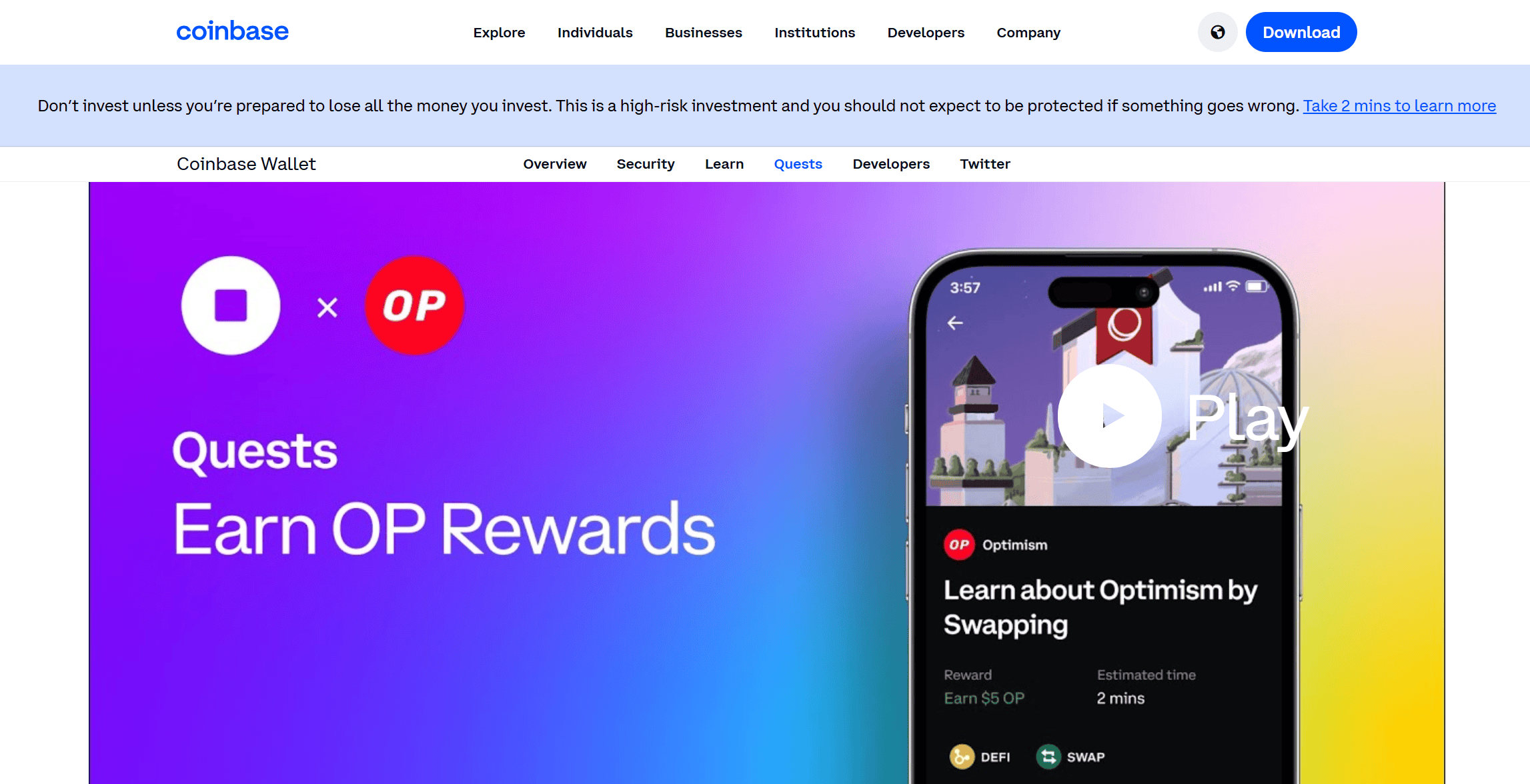
For example, a quest might ask you to swap tokens, stake a small amount, or collect an NFT. Once you finish, you receive a small crypto reward.
What makes it stand out:
- Interactive and hands-on. You learn by doing, not just watching videos.
- Rewards are credited directly in your wallet.
- Covers multiple blockchains, not just Ethereum.
What to keep in mind:
- Some quests require gas fees, so you might need a small balance of ETH or another token to complete the task.
- Regional restrictions apply. Not all quests are available everywhere.
Overall, Coinbase Wallet Quests are great for beginners who want to practice real blockchain actions without spending much money. You’ll gain confidence using wallets while earning small rewards.
Binance Learn & Earn
Binance runs one of the largest Learn-to-Earn programs through its Academy and app. Users watch short tutorials about a new project, then answer quiz questions. If you pass, you receive that project’s tokens as a reward.
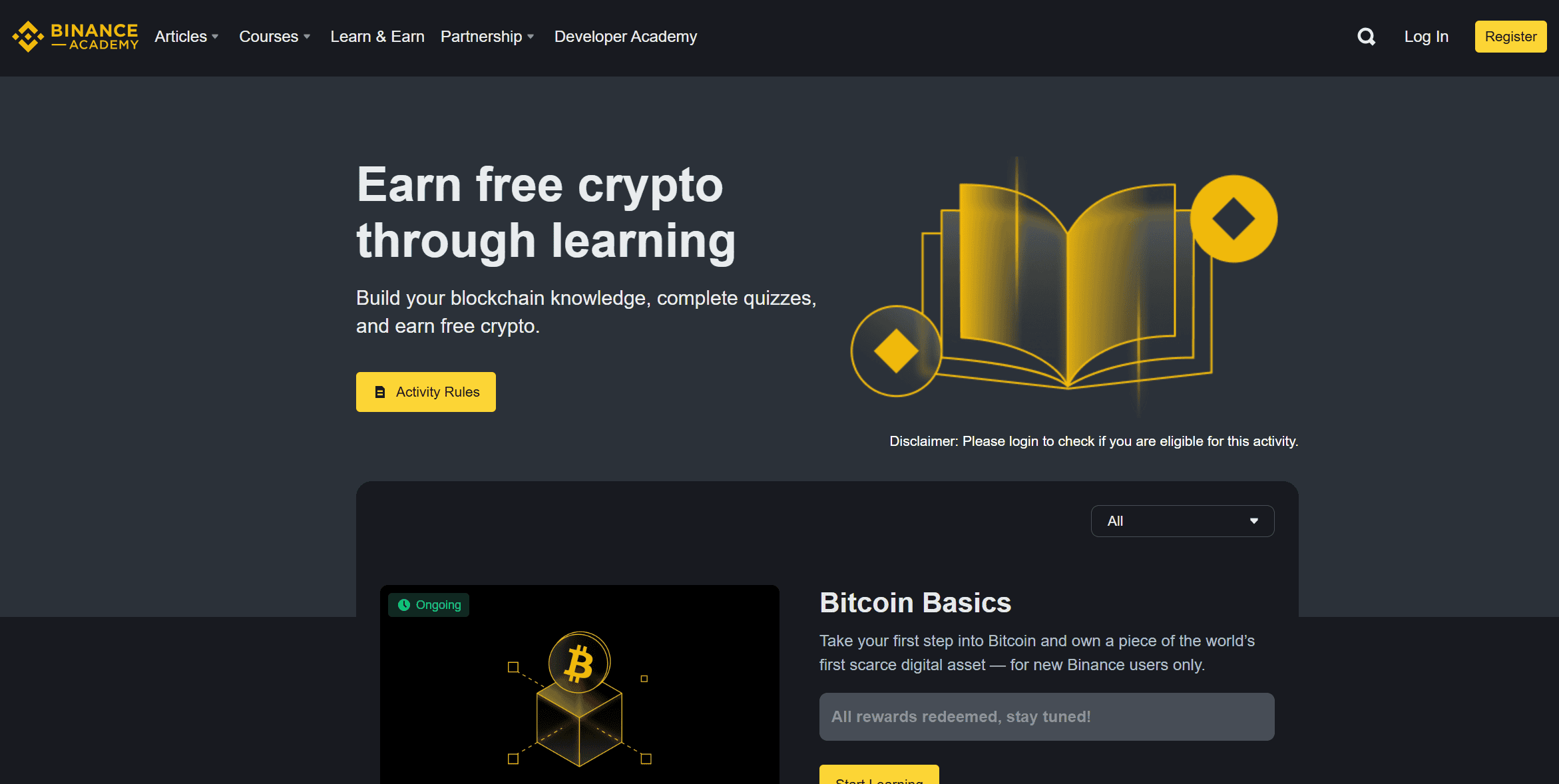
Highlights:
- Covers trending projects listed on Binance.
- Lessons are short and beginner-friendly.
- Rewards are usually project-specific tokens.
Limitations:
- Only available to new Binance accounts. If you’ve been a user for a while, you might not qualify.
- Not available in certain countries, including the U.S.
Binance Learn & Earn is best if you’re a newcomer who’s opening your first exchange account. The program gives you free tokens and helps you understand the projects you may trade later.
CoinMarketCap Earn
CoinMarketCap (CMC), one of the most popular crypto data websites, also runs a Learn-to-Earn program.

It’s pretty simple: you watch short video lessons about a project, then complete a short quiz. If you pass, you receive the project’s tokens directly in your CMC-linked exchange account (often Binance or other supported partners).
Why people like it:
- Content is straightforward, usually a 3–5 minute video.
- Rewards are in tokens from real projects like BNB, TRX, or other trending coins.
- It’s accessible to most users globally, since CoinMarketCap is widely available.
Things to know:
- Rewards are time-sensitive. Each campaign runs until the token pool is distributed, so if you’re late, you may not get anything.
- Some lessons are beginner-friendly, but others can feel like advertisements for the featured project.
- You usually need a supported exchange account (like Binance) linked to CoinMarketCap to claim your tokens.
For beginners, CoinMarketCap Earn is one of the easiest entry points into L2E. You don’t need to risk your own funds, and the lessons introduce you to projects you might see in the market anyway. Just remember to check the Earn section regularly. The rewards can run out quickly once a campaign goes live (yes, that’s a thing).
Phemex Learn & Earn
Phemex, a global crypto exchange, has its own twist on Learn-to-Earn. Instead of giving out free tokens, it rewards users with trading credits that can be used to reduce fees or pay for transactions on the platform.
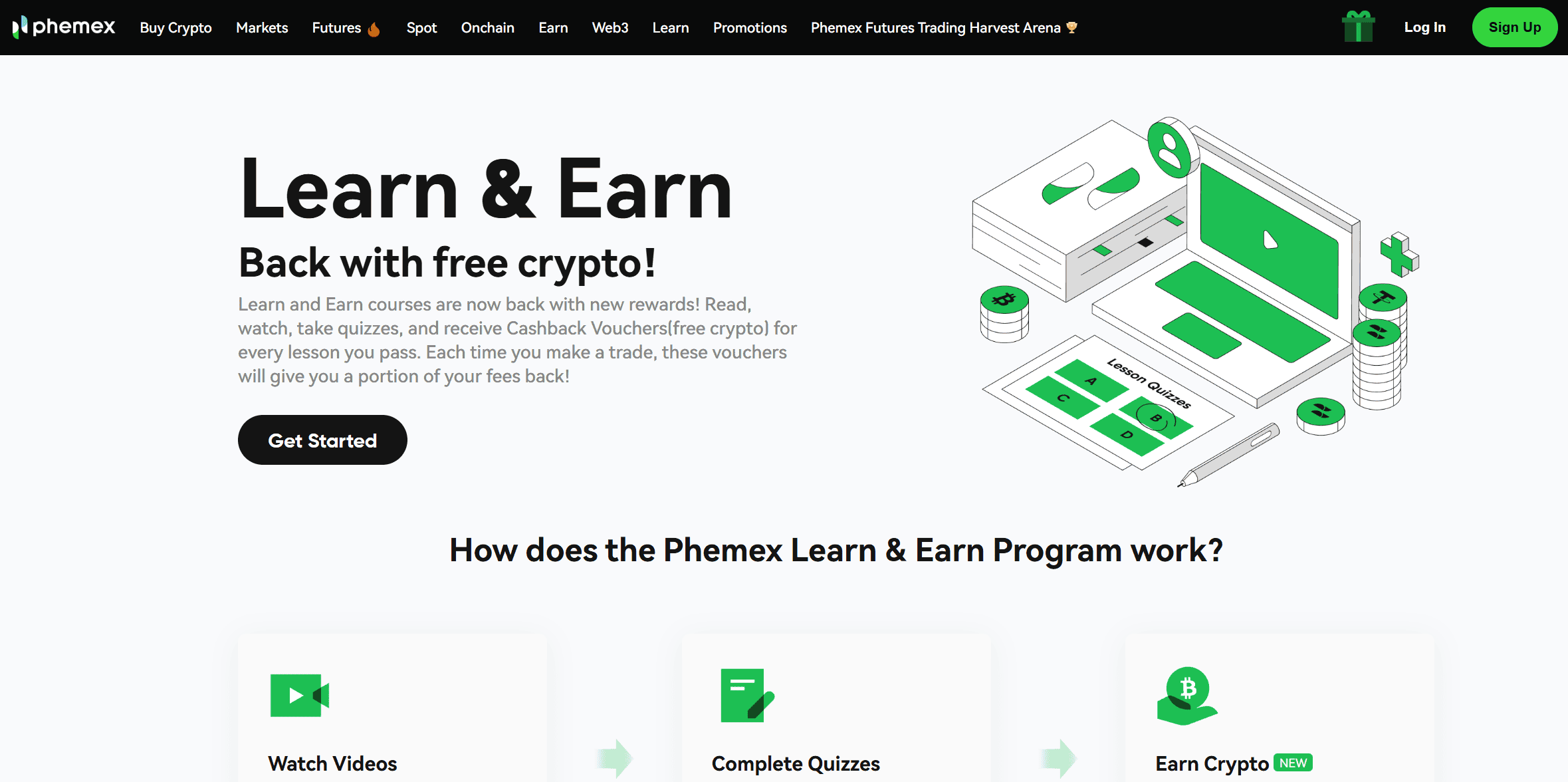
To earn, you watch short educational videos and answer quizzes, similar to how Binance or CoinMarketCap work.
Why it stands out:
- Rewards are flexible credits. While not direct tokens, they save you money by lowering fees, which is valuable if you plan to trade.
- Lessons cover both basic crypto topics and Phemex-specific features.
- It’s accessible to new and existing users, unlike some exchanges that only target newcomers.
What to watch out for:
- Rewards are modest, usually worth about $0.50 to $1 per module.
- Since rewards are credits, they don’t build up a token portfolio in the same way other L2E programs do.
- Phemex requires an exchange account, and you’ll need to complete registration before participating.
For users who are curious about trading, Phemex Learn & Earn is a smart option. It won’t grow your portfolio directly, but it cuts costs and helps you get comfortable with crypto concepts while preparing you for real trading activity.
BitDegree Missions
BitDegree is a learning-focused platform that offers a combo of education and gamification. Its “Missions” are structured like small quests: you complete a course or task, and you get rewarded with Bits (points), crypto tokens, stablecoins, or even NFTs.
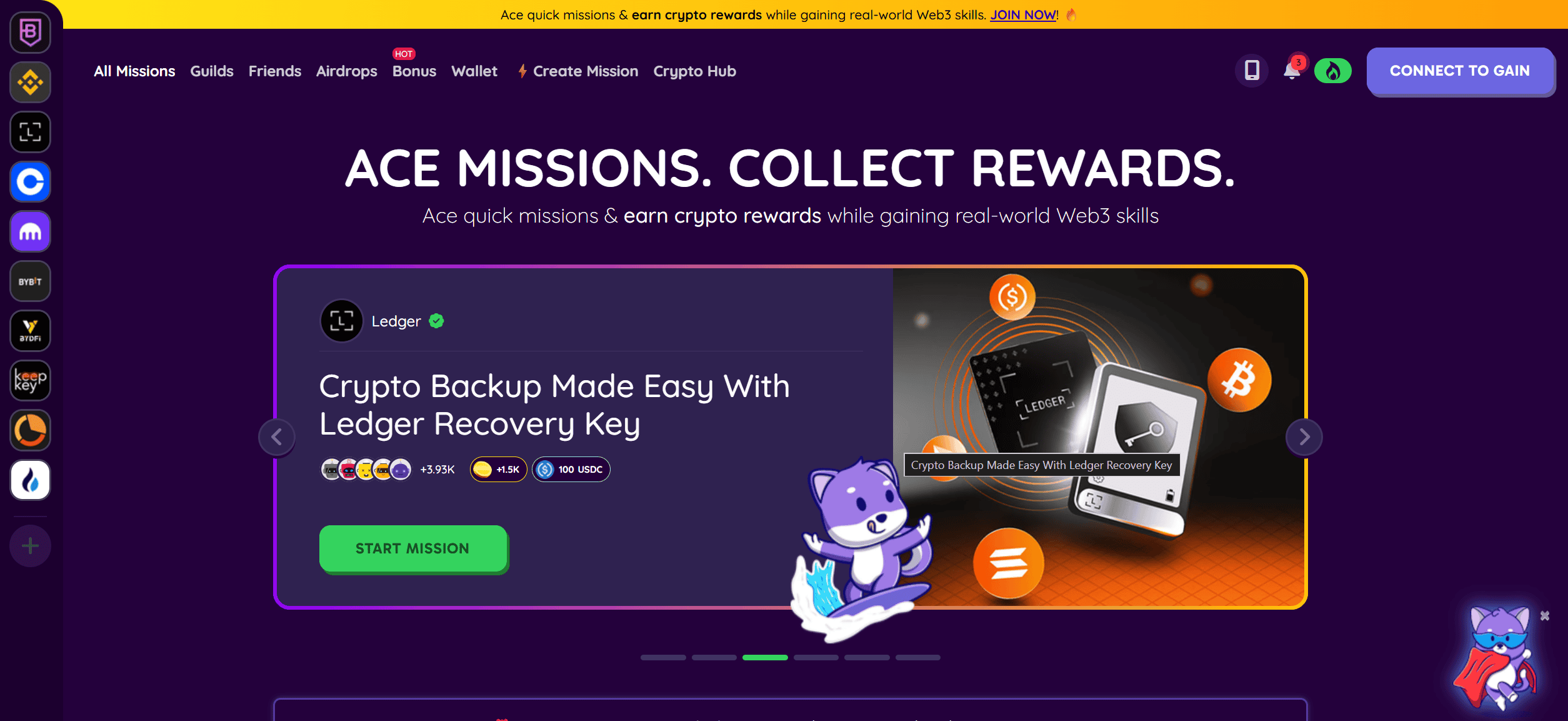
Unlike most exchange-based programs, BitDegree is more like an online academy designed for long-term learning, and not quick one-off campaigns.
Why it’s unique:
- Covers a wide range of topics. Not just crypto basics, but also blockchain development, DeFi, NFTs, and even AI.
- Rewards can be more varied than just tokens, which makes it feel more like a gamified experience.
- You can track your progress with achievements and leaderboards, which adds motivation.
Things to consider:
- Some rewards are paid in BitDegree’s own point system (Bits), which you can later exchange or use within the platform.
- Depending on the course, lessons can be longer and more detailed than the quick-hit style of Binance or CMC.
- It’s not tied to a big exchange, so the onboarding may feel slightly less streamlined.
For users who want a deeper dive into crypto knowledge rather than just grabbing a quick token reward, BitDegree Missions are a solid choice. It’s especially good for beginners who enjoy learning in a structured, gamified way.
CoinGecko Learn
CoinGecko, best known as a crypto price-tracking website (similar to CoinMarketCap), also offers a Learn-to-Earn section. Lessons are short and approachable, usually a mix of videos and quizzes that focus on trending projects or basic crypto concepts.
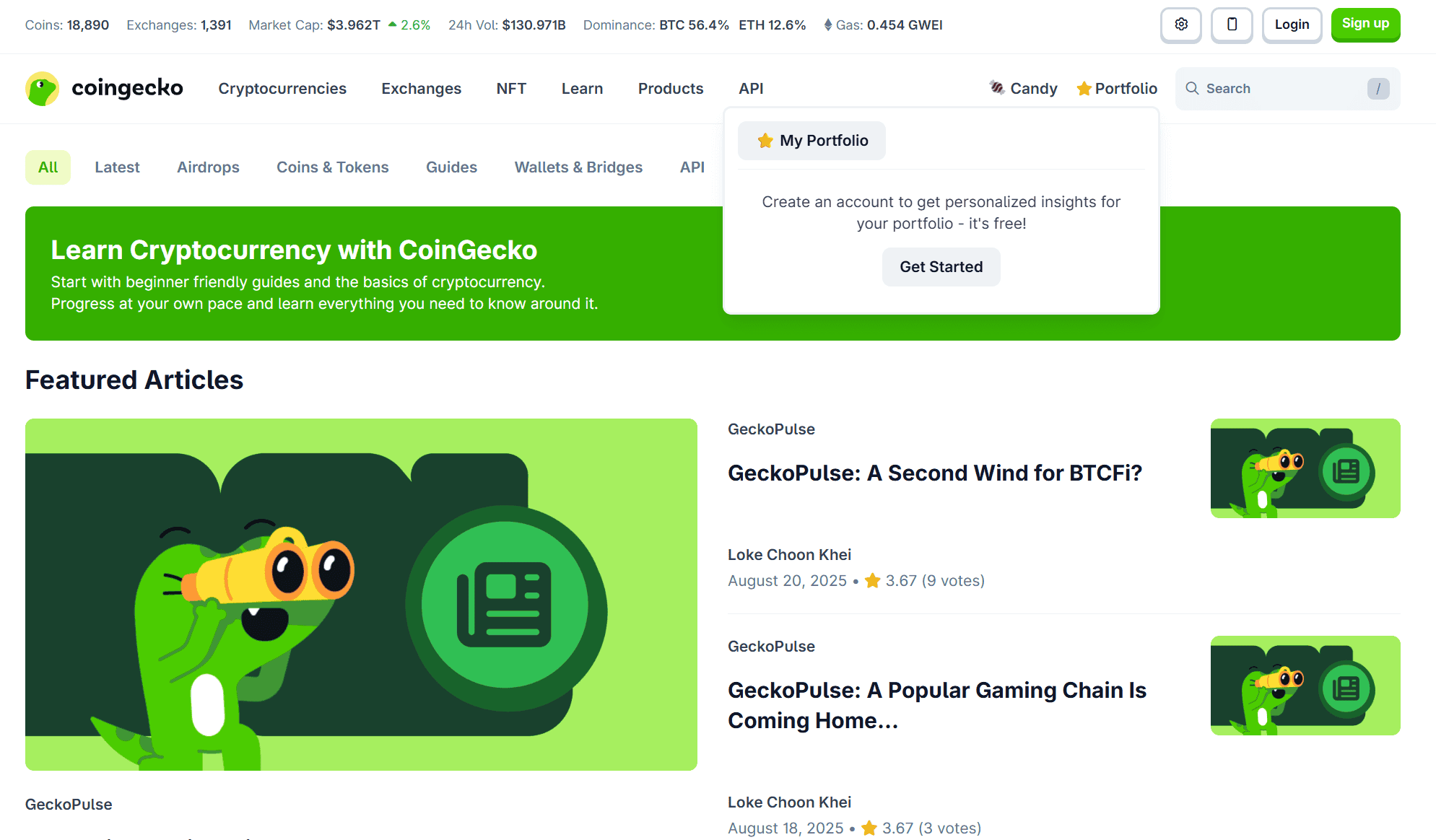
Completing a lesson gives you small amounts of crypto or “Candy,” which are in-platform points you can redeem for rewards.
Highlights:
- Very beginner-friendly, since lessons are short and easy to follow.
- Rewards often include both tokens and Candy points, giving you two ways to benefit.
- CoinGecko regularly updates content with new lessons tied to fresh projects.
Drawbacks:
- Rewards are small and can run out quickly once a campaign is popular.
- Candy points aren’t crypto by themselves — you need to redeem them for gift cards, discounts, or other perks.
- Like CMC, availability depends on whether the campaign has tokens left in its pool.
CoinGecko Learn is a great fit for beginners who already use the site to track coin prices. It’s simple, fast, and requires no heavy commitment. While the rewards are modest, it’s an easy way to get started and stay in the loop on new projects.
How to get started with Learn-to-Earn
You don’t need much to begin with L2E, but there are a few steps that will help you get set up quickly and avoid missing out on rewards.
1. Choose your platform
- If you want hands-on learning, start with Coinbase Wallet Quests.
- If you prefer simple quizzes and videos, try CoinMarketCap Earn or CoinGecko Learn.
- If you already plan to trade, Phemex Learn & Earn is useful since it reduces fees.
2. Create an account
- Sign up on the chosen platform.
- Many exchanges and wallets require KYC verification (an ID check) before you can claim rewards. This helps prevent fraud and duplicate accounts.
3. Explore the Learn-to-Earn section
- Look for the “Learn” or “Earn” tab in the app or website.
- Browse available lessons. Some platforms run limited-time campaigns, while others have ongoing tutorials.
4. Complete a lesson
- Watch the video, read the article, or follow the on-screen tutorial.
- Take the quiz or finish the blockchain task (like swapping or staking a small token).
5. Collect your reward
- Tokens, credits, or points are automatically added to your wallet or account once you succeed.
- Some rewards may take a few days to appear, depending on the platform.
6. Keep checking back
- New campaigns are released regularly, but rewards can run out fast once users claim them.
- Setting a reminder to check once a week can help you catch fresh lessons early.
Tips for beginners
Getting free crypto for learning is exciting. But there are a few things you should know before diving in, especially if you’re a beginner.
1. Rewards are small – focus on the learning
Most programs only give a few dollars’ worth of tokens or credits per lesson. Don’t expect to get rich. The real value is in the knowledge you build, not the payout.
2. Check availability
- Some campaigns are limited by region. For example, Binance Learn & Earn isn’t available in the U.S.
- Rewards can run out quickly when token pools are distributed on a first-come, first-served basis. Logging in regularly helps you catch new lessons.
3. Be prepared for KYC
Most exchange-based platforms (like Binance or Phemex) require ID verification before you can claim rewards. This is normal and helps prevent abuse of the system.
4. Watch out for gas fees
Some quests (like Coinbase Wallet Quests) may require you to pay a small blockchain transaction fee. Usually it’s minimal, but it’s good to know you might need a couple of dollars in ETH or another token to complete tasks.
5. Stick to official platforms
Scams often copy the branding of popular L2E programs. Always go directly to the official website or app instead of clicking on random links.
6. Mix and match platforms
You don’t have to stick to just one program. You can try several, like CoinGecko for bite-sized lessons and Coinbase Wallet for interactive quests. This way, you get the best of both worlds. Plus, you learn more.
The bottom line: learning and earning
Learn-to-Earn programs give beginners a safe, simple way to step into the crypto world.
The key thing to remember is that L2E isn’t about making big profits. It’s about gaining confidence and understanding. The tokens or credits you earn are a bonus, but the real value is the knowledge you collect. Over time, that knowledge will help you navigate wallets, exchanges, and new crypto projects much more comfortably.
For beginners, the best approach is to try a mix of platforms. Start with a simple quiz-based program like CoinGecko Learn or CoinMarketCap Earn, then move on to something more interactive like Coinbase Wallet Quests once you’re ready. Along the way, keep an eye out for new campaigns, since many programs refresh their lessons regularly.





